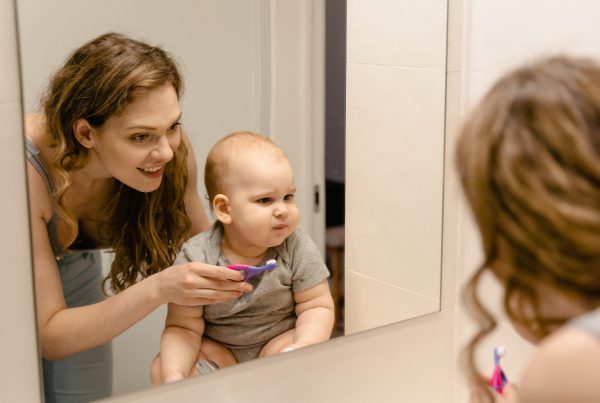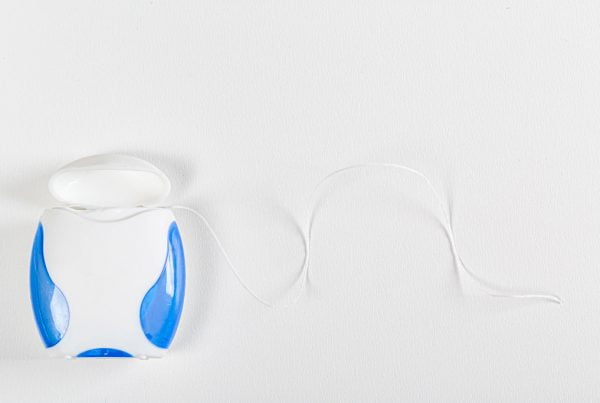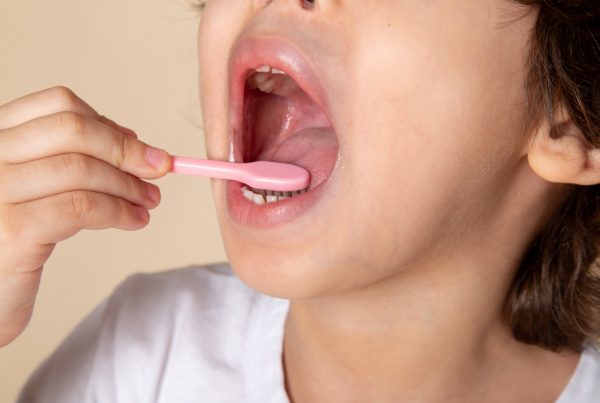- How to brush a baby’s teeth
- Why early oral hygiene is so important for babies
- How to care for your baby’s first teeth
- Does the choice of oral hygiene accessories matter?
- Tooth brushing technique for infants
- Take care of your baby’s teeth from the beginning — when should the first dental visit take place?
- Infant oral hygiene – summary
How to brush a baby’s teeth
The first months of a baby’s life are a time of rapid change and learning, especially for parents who want to provide the best care possible. Among the many challenges that come with parenthood, one important question arises: when and how should you start caring for your baby’s oral hygiene? Contrary to what some may think, taking care of baby teeth is essential for both current and future health. Regular oral care helps prevent issues like tooth decay and encourages the development of good hygiene habits that will last a lifetime.
Why early oral hygiene is so important for babies
Proper oral hygiene plays a vital role in a child’s overall development from the very beginning. Even before the first baby teeth appear, cleaning the gums with boiled water helps remove leftover milk and bacteria, reducing the risk of infections. Once teeth begin to erupt, daily hygiene becomes even more important, as baby tooth enamel is more vulnerable to cavities. Healthy baby teeth support proper chewing, speech development, and provide the necessary space for permanent teeth. Early care teaches hygiene habits and makes future dental visits less stressful. Neglecting oral care in infancy can lead to serious health problems that impact a child’s development.
How to care for your baby’s first teeth
Caring for a baby’s gums should start earlier than most parents think — even before any teeth are visible. Here’s how to begin:
1. Gum hygiene
From the first weeks of life, gently clean your baby’s gums after feedings, especially if bottle-fed. Use:
- a soft, damp cloth or gauze wrapped around your finger to wipe the gums (you can use chamomile tea),
- a silicone fingertip brush with soft bristles designed for babies.
This routine prevents food particles and bacteria from building up and helps your baby get used to oral care, making the transition to tooth brushing easier later on.
2. After the first tooth erupts
The first baby tooth usually appears around six months of age, though it may happen earlier or later. Once the tooth is visible, begin brushing it daily because baby teeth are highly susceptible to decay. To clean the tooth:
- use a fingertip brush or a baby toothbrush with a small head and very soft bristles,
- apply a tiny amount of fluoride toothpaste (about the size of a grain of rice),
- clean the tooth with gentle, sweeping motions to remove milk residue,
- wipe off any excess toothpaste with gauze if necessary.
3. As more teeth appear
As more teeth erupt during the first year, it’s essential to:
- brush all visible teeth every morning and evening,
- stick to a consistent routine to establish healthy habits,
- monitor the gums for signs of discomfort — teething can be painful, so use cooling teething rings or pediatric-approved gels to soothe irritation.
Does the choice of oral hygiene accessories matter?
The right tools can make a big difference in your baby’s oral health. Here’s what you should include:
- Toothbrush: Choose one with ultra-soft bristles and a small head. A silicone fingertip brush works well in the beginning for massaging gums and cleaning baby teeth gently.
- Toothpaste: For babies under two, use fluoride toothpaste with a concentration of around 1000 ppm. Use a rice-sized amount, as babies can’t yet spit out the paste or rinse properly. The toothpaste should be mild in taste and texture.
- Gum cleaning accessories: Use damp gauze or a silicone brush with soft bristles to clean the gums before teeth emerge. This also provides comfort during teething.
- Teething rings with cleaning surfaces: Some teething toys feature textures that help clean the gums while soothing teething pain.
- Storage case: Store the toothbrush in a clean, dry container to protect it from germs and contamination.
Make sure all accessories are made from safe, non-toxic materials and replace toothbrushes every 2–3 months or sooner if the bristles become misshapen.
READ MORE: Throbbing tooth pain
Tooth brushing technique for infants
In the early stage, clean the gums using damp gauze or a silicone brush. Once the first tooth erupts, introduce a soft toothbrush with a small head and a tiny bit of fluoride toothpaste. Brush using short, gentle sweeping motions to clean the teeth, gums, and tongue. Do this twice a day — morning and evening — in a calm setting to help your baby associate brushing with comfort. Consistency, patience, and positive reinforcement are key to helping your child accept oral hygiene as a daily habit.
Take care of your baby’s teeth from the beginning — when should the first dental visit take place?
The first dental visit should happen around the baby’s first birthday or when the first tooth appears. This milestone is crucial in preventing dental issues, such as bottle caries. A pediatric dentist will examine the baby’s teeth and gums and offer guidance on oral hygiene and diet. The visit also provides a chance to discuss topics like teething, fluoride use, feeding habits, and choosing the right oral care products. Regular dental checkups allow early detection of potential issues and help children feel comfortable with dental care from a young age.
Infant oral hygiene – summary
Caring for your baby’s oral hygiene is essential, even before the first tooth appears. It’s not just about appearance — it’s about long-term health. Establishing a consistent oral care routine from the start helps prevent cavities and gum disease and sets the foundation for lifelong habits. Parents play a crucial role by fostering positive associations and practicing patience. Baby teeth mark the beginning of a healthy smile that will last a lifetime. Brushing a baby’s teeth may not be easy, but it’s absolutely worth the effort. Don’t forget to clean not only the gums but also the tongue and the inner cheeks. Avoid harsh movements, stay consistent, and make sure both you and your baby are comfortable. With regular cleaning, your baby’s teeth will stay healthy and strong.






